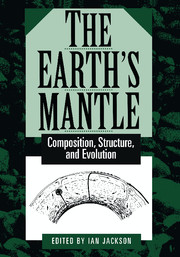Book contents
- Frontmatter
- Contents
- Chapter Outlines
- Contributors
- Dedication
- Preface
- I Accretion and Differentiation of the Earth
- II Dynamics and Evolution of the Earth's Mantle
- 4 Understanding Mantle Dynamics through Mathematical Models and Laboratory Experiments
- 5 Plates, Plumes, Mantle Convection, and Mantle Evolution
- 6 The Mantle's Chemical Structure: Insights from the Melting Products of Mantle Plumes
- 7 Pyrolite: A Ringwood Concept and Its Current Expression
- III Structure and Mechanical Behaviour of the Modern Mantle
- Index
4 - Understanding Mantle Dynamics through Mathematical Models and Laboratory Experiments
Published online by Cambridge University Press: 23 November 2009
- Frontmatter
- Contents
- Chapter Outlines
- Contributors
- Dedication
- Preface
- I Accretion and Differentiation of the Earth
- II Dynamics and Evolution of the Earth's Mantle
- 4 Understanding Mantle Dynamics through Mathematical Models and Laboratory Experiments
- 5 Plates, Plumes, Mantle Convection, and Mantle Evolution
- 6 The Mantle's Chemical Structure: Insights from the Melting Products of Mantle Plumes
- 7 Pyrolite: A Ringwood Concept and Its Current Expression
- III Structure and Mechanical Behaviour of the Modern Mantle
- Index
Summary
Introduction
Many geophysical and geological phenomena of the Earth's crust are now generally agreed to be consequences of thermal convection in the underlying mantle. Direct consequences include the relative motions of the continents, the spreading of the seafloor and formation of new crust, volcanism in its various tectonic settings, much of the Earth's seismic activity, and the magnitude of the observed heat flow through the surface. The flow of the mantle over geological time scales is driven by gravity acting on density differences that result from loss of heat from the Earth's surface and, to a lesser extent, from transfer of heat from the Earth's core to the mantle.
The current understanding of the nature of mantle convection and of the evolution of the Earth is based on a combination of observations made at the surface and deductions arrived at through application of the principles of physics. It depends on knowledge of the physical properties of mantle materials and an understanding of the macroscopic dynamical processes whereby those materials respond to the applied forces coupled to the thermodynamics of the system. This chapter is concerned with the latter part of the problem: the identification and study of various physical and dynamical phenomena in the mantle. In particular, we shall discuss the use of theoretical and experimental fluid dynamics as important contributors to the present state of understanding of the Earth, many aspects of which are outlined in this volume.
Information
- Type
- Chapter
- Information
- The Earth's MantleComposition, Structure, and Evolution, pp. 191 - 227Publisher: Cambridge University PressPrint publication year: 1998
